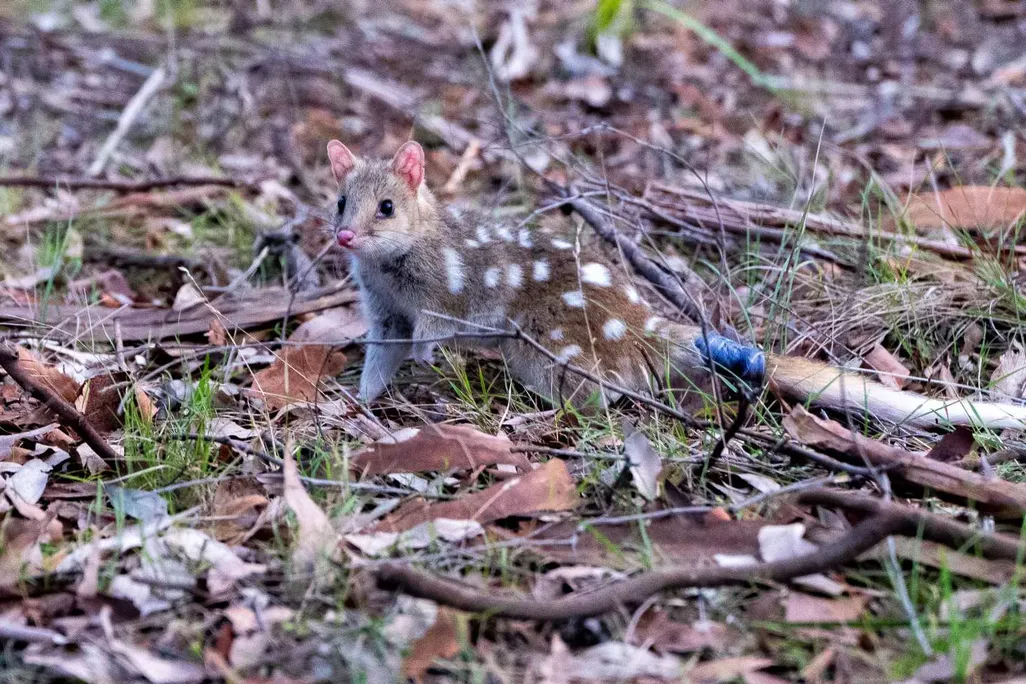See Eastern Quolls Get Released on Mainland Australia in a New Bid to Re-establish the 'Magic Little Animal'
See Eastern Quolls Get Released on Mainland Australia in a New Bid to Re-establish the ‘Magic Little Animal’
Conservationists recently introduced 15 of the polka-dotted marsupials into a protected area of New South Wales
Eastern quolls went extinct on mainland Australia in 1963.
Aussie Ark
Eastern quolls were once abundant in southeast Australia. But in 1963, the small, polka-dotted marsupials disappeared from the mainland, with the only surviving wild population living on the island state of Tasmania.
Now, however, with help from conservationists, the bushy-tailed critters are slowly returning to the mainland. Biologists recently released 15 endangered eastern quolls (Dasyurus viverrinus) into a protected site in the state of New South Wales.
The captive-bred carnivores were introduced into a “controlled bushland environment” near the town of Nowra, according to a statement from the University of Sydney. The university teamed up with the Jerrinja Indigenous people, as well as the wildlife conservation group Aussie Ark, on the project.
The 168-acre site is located on the Bannockburn campus of the Scots College, a Presbyterian boys’ school. This is the first time eastern quolls have been released on the site, though they’ve been reintroduced in other parts of New South Wales in recent years.
EASTERN QUOLLS RELEASED INTO NSW BUSHLAND!
Watch on
Ron Carberry, a Jerrinja tribal leader, describes the release as a “magnificent moment” for the “magic little animal.”
“It’s about healing Country,” he says in the statement.
Researchers plan to keep a close eye on the 15 eastern quolls, which are each about the size of a small domestic cat. Scientists have affixed radio and GPS tracking devices to their tails, and they’ve set up 54 trail cameras around the site. They also plan to capture the creatures once every three months to see how they’re faring.
The project will allow researchers to do a “deep dive into the ecology” of the species, says Thomas Newsome, an ecologist at the University of Sydney, in the statement.
“We need to better understand the quoll’s role in an ecosystem from which it has been absent from for almost 70 years,” he adds.The recent release is part of a broader “rewilding” effort for eastern quolls on mainland Australia. Starting in 2018, conservationists began releasing batches of captive-bred eastern quolls into Booderee National Park, also in New South Wales. But none of those creatures or their descendants survived, reported the Australian Broadcasting Corporation’s James Glenday and Adam Kennedy in 2021.
Undeterred, researchers installed a 2.5-mile fence within the national park, a barrier designed to keep foxes and cats out. Last year, they released 19 eastern quolls into the roughly 200-acre fenced area, which was also equipped with trail cameras and supplementary feeding stations.
“We saw in the first reintroduction a really high mortality rate in the first three months and then the rest actually learned how to hunt, scavenge and evade predators,” said Rob Brewster, rewilding program manager for WWF-Australia, to the Australian Broadcasting Corporation’s Romy Gilbert last year. “So, we’re testing it again within this fenced haven to grow the population and make it stick.”
In a bid to boost their numbers, captive-bred eastern quolls have also been released in Tasmania. The animals have been able to maintain a wild population on the island due to the absence of foxes, but their numbers have been shrinking in recent years. Scientists are still trying to understand the declines, but they suspect climate change, habitat loss and feral predators may be at play. In February, conservationists released 24 eastern quolls onto private property in Tasmania’s Midlands region.
The critters have also been reintroduced in Victoria, the state just south of New South Wales.
Scientists affix a tracking device to a quoll's tail.
Aussie Ark
Conservationists say eastern quolls play an important role in Australia’s ecosystems. As predators, they help keep populations of insects, mice, rats and rabbits in check.
Beyond their importance for biodiversity, the creatures are culturally significant to many Indigenous groups in Australia. The word “quoll” comes from Guugu Yimithirr, an Aboriginal language, according to the Australian National University.
Eastern quolls also happen to be adorable, with a penchant for frolicking around and getting the zoomies.
“If you go into an open grassland that is just jumping with eastern quolls, it’s the most delightful sight in the world,” said David Hamilton, an ecologist with the Tasmanian Land Conservancy, to the Australian Broadcasting Corporation’s Mackenzie Heard in March. “They look like they’re full of joy every time they move, which is just something that makes my heart sing.”
Get the latest stories in your inbox every weekday.


